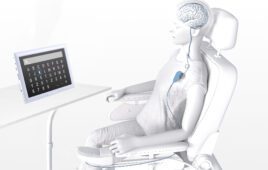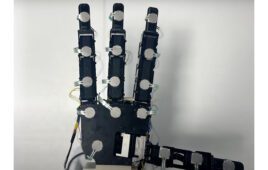New England Journal of Medicine Case Study Highlights Unprecedented Technology for Lower-Limb Amputees
 The science of bionics helped the more than one million Americans1 with leg amputations take a giant step forward, as the Rehabilitation Institute of Chicago (RIC) revealed clinical applications for the world’s first thought-controlled bionic leg in the September 26, 2013 issue of The New England Journal of Medicine. This innovative technology represents a significant milestone in the rapidly growing field of bionics. Until now, only thought-controlled bionic arms were available to amputees.
The science of bionics helped the more than one million Americans1 with leg amputations take a giant step forward, as the Rehabilitation Institute of Chicago (RIC) revealed clinical applications for the world’s first thought-controlled bionic leg in the September 26, 2013 issue of The New England Journal of Medicine. This innovative technology represents a significant milestone in the rapidly growing field of bionics. Until now, only thought-controlled bionic arms were available to amputees.
Levi Hargrove, PhD, the lead scientist of this research at RIC’s Center for Bionic Medicine, developed a system to use neural signals to safely improve limb control of a bionic leg.
Photos of the Day: Walking with the Mind
“This new bionic leg features incredibly intelligent engineering,” said Hargrove. “It learns and performs activities unprecedented for any leg amputee, including seamless transitions between sitting, walking, ascending and descending stairs and ramps and repositioning the leg while seated.”
This method improves upon prosthetic legs that only use robotic sensors and remote controls and do not allow for intuitive thought control of the prosthetic.
The case study focuses on RIC research subject Zac Vawter, a lower-limb amputee who underwent targeted muscle reinnervation surgery – a procedure developed at RIC and Northwestern University – in 2009 to redirect nerves from damaged muscle in his amputated limb to healthy hamstring muscle above his knee. When the redirected nerves instruct the muscles to contract, sensors on the patient’s leg detect tiny electrical signals from the muscles. A specially-designed computer program analyzes these signals and data from sensors in the robotic leg. It instantaneously decodes the type of movement the patient is trying to perform and then sends those commands to the robotic leg. Using muscle signals, instead of robotic sensors, makes the system safer and more intuitive.
“The bionic leg is a big improvement compared to my regular prosthetic leg,” stated Vawter. “The bionic leg responds quickly and more appropriately, allowing me to interact with my environment in a way that is similar to how I moved before my amputation. For the first time since my injury, the bionic leg allows me to seamlessly walk up and down stairs and even reposition the prosthetic by thinking about the movement I want to perform. This is a huge milestone for me and for all leg amputees.”
Army Funding
More than 1,200 leg amputees in the United States are recently injured servicemen and women.2
The US Army’s Telemedicine and Advanced Technology Research Center (TATRC) funded the RIC study with an $8 million grant to improve the control of advanced robotic leg prostheses by adding neural information to the control system. Due to this unusually large TATRC grant for the rehabilitation field and a multi-disciplinary team, RIC was able to accomplish these breakthrough innovations in only four years.
“We are pleased to partner with the RIC Center for Bionic Medicine in the development of user intent controlled bionic limbs,” said Col. John Scherer, director of the Clinical and Rehabilitative Medicine Program at the US Army Medical Research and Materiel Command. “We appreciate the opportunity to sponsor this life-changing effort to provide military amputees with as much physical functionality as possible, as soon as possible.”
This partnership aims to make these bionic legs available for in-home testing for both the military and civilian populations within the next five years.
For more information, visit www.ric.org.
1K. Ziegler-Graham, “Estimating the Prevalence of Limb Loss in the United States: 2005 to 2050,” Arch Phys Med Rehabil, vol. 89, pp. 422-429, 2008.
2C. Krueger, J. Wenke, and J. Ficke, “Ten years at war: Comprehensive analysis of amputation trends,” J Trauma Acute Care Surg, vol. 73, pp. S438-S444, 2012.




